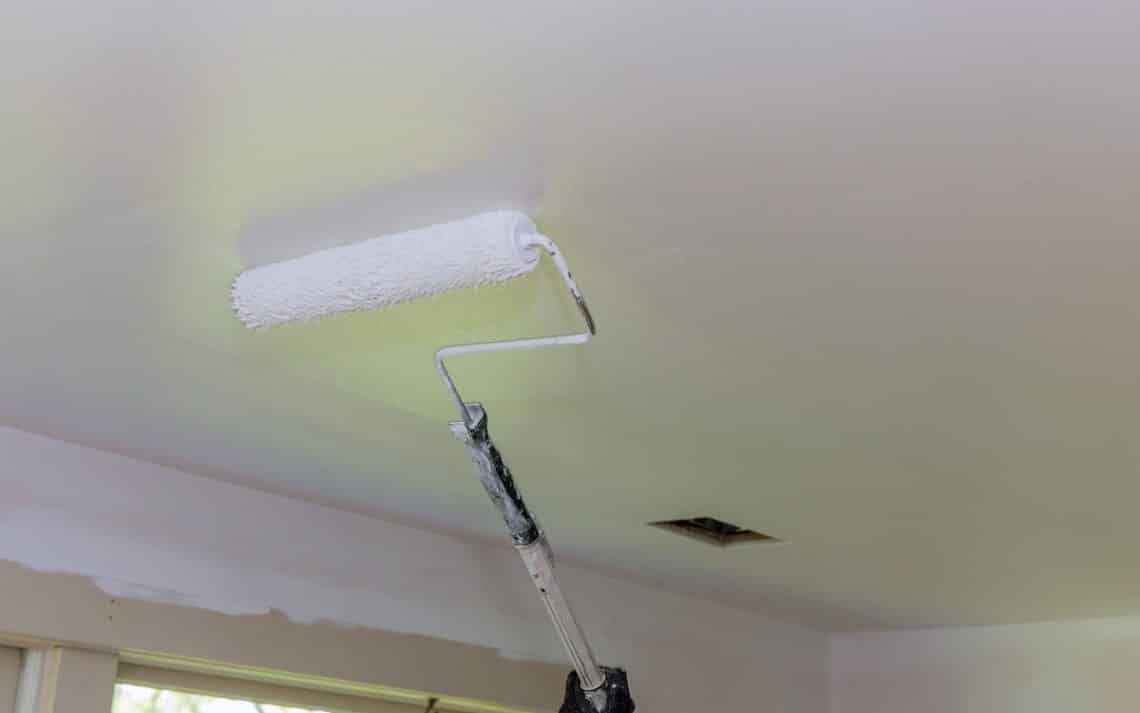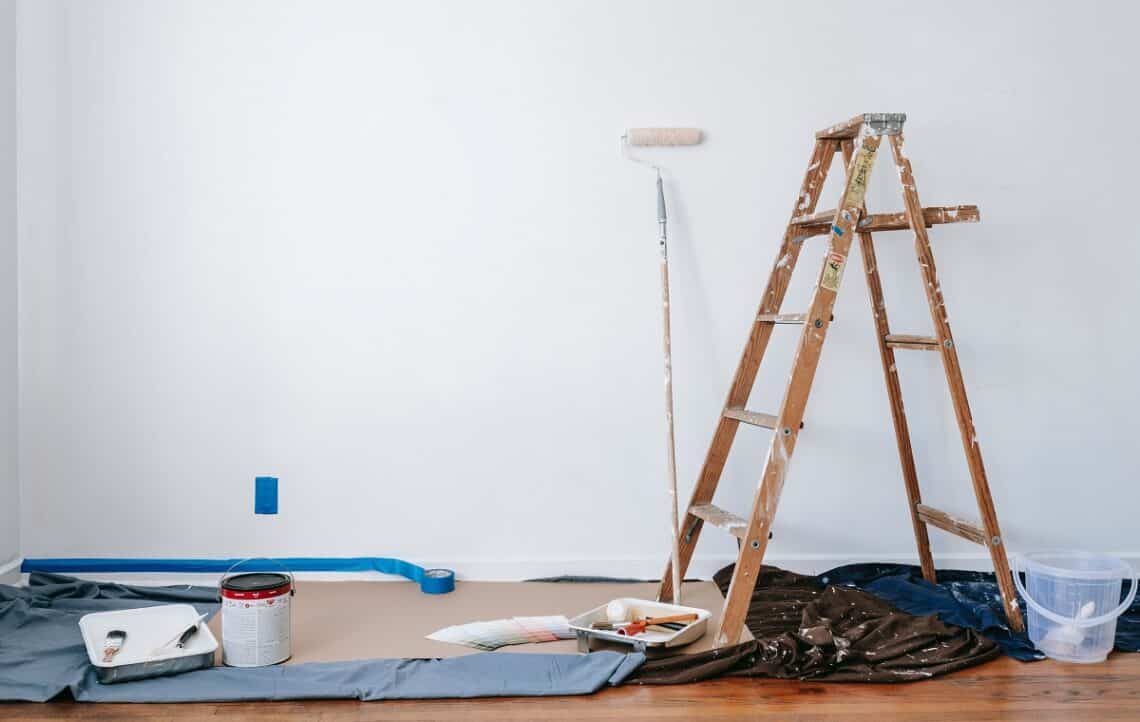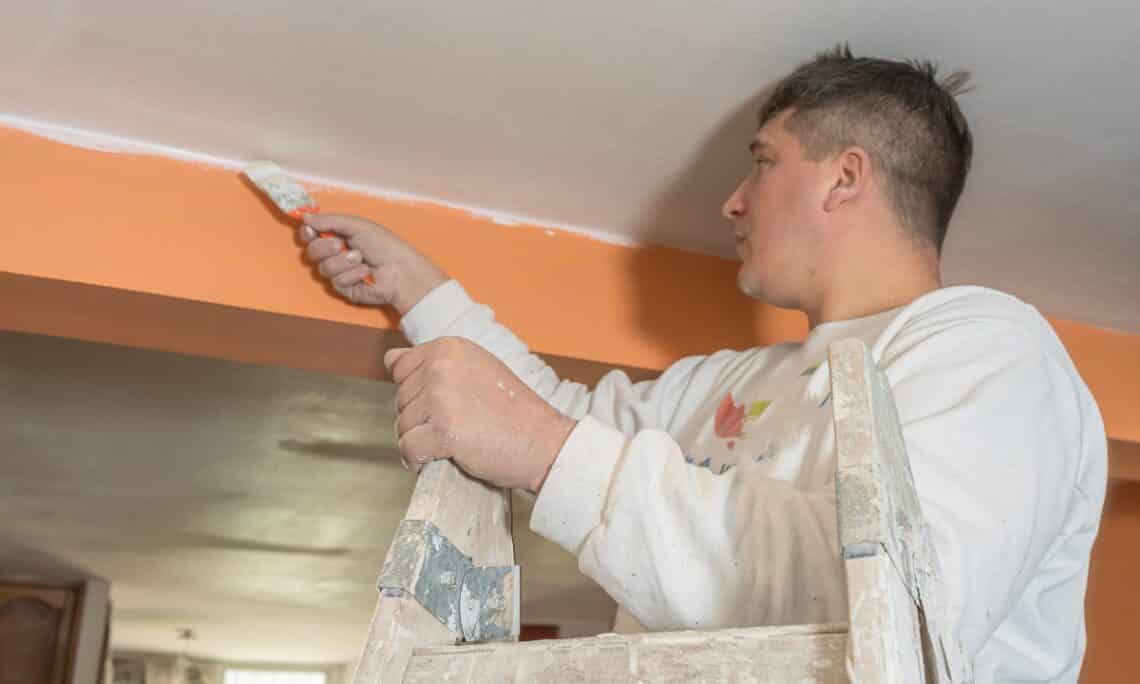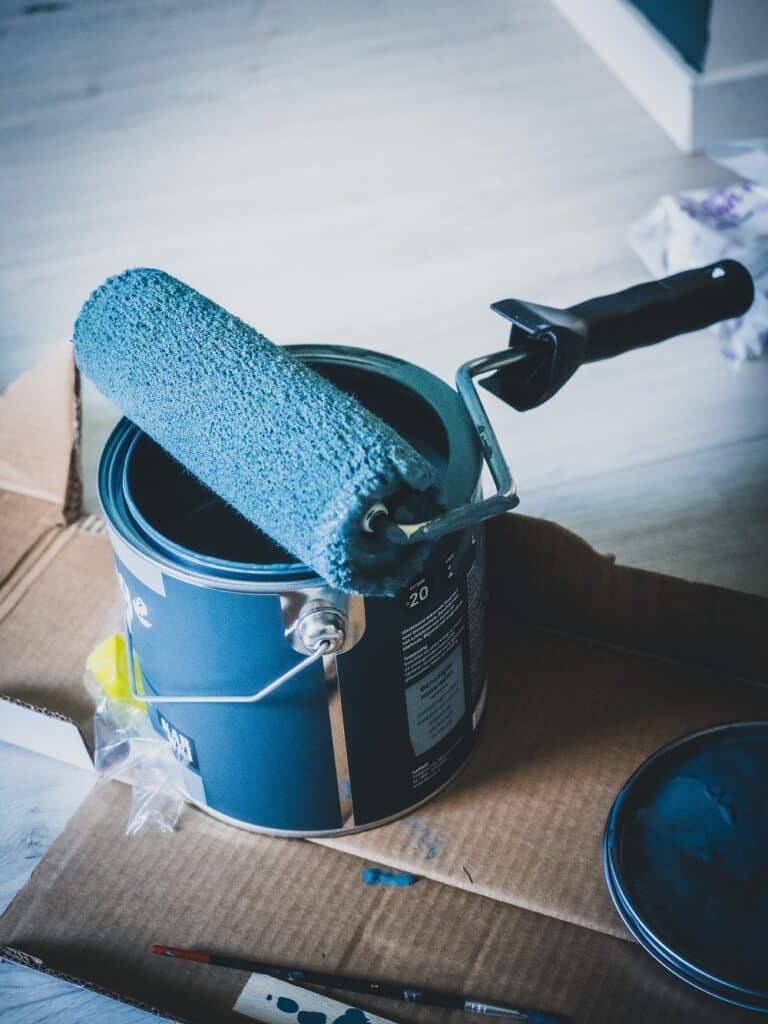Ceiling paint and wall paint- are both of them different, or can you use them interchangeably?
If you have been thinking of renovating your home, these questions are bound to arise. After all, why buy two different types of paint if you can easily use one of them on the walls as well as the ceilings.
Technically, you can use the ceiling paint on the wall and vice versa, but it’s not as straightforward as that. There are a few things you should know and prepare beforehand, and that’s what we’ll discuss further in this article. Let’s find out the features of ceiling paint and wall paint and see the difference between the two.
Difference Between Ceiling Paint And Wall Paint

Ceiling Paint 101
1. Coverage
One of the benefits of ceiling paint is the smooth and even finish you get after each application. Since the ceiling paint is much more viscous, one application provides depth to the layer and gives an opaque finish. This means that fewer coats are required to cover up stains and imperfections with ceiling paint.
It’s better to opt for latex paint or any other thicker option like satin paint when using brushes and rollers. But these paints will not work in combination with a paint sprayer because spraying requires a thinner paint consistency.
And painting the ceiling might need thinner paint for proper application. But if hiding ceiling imperfections is essential, use a roller with regular ceiling paint, which should work well.
2. Viscosity
Any paint you apply to the ceiling cannot be too thin for obvious reasons. If you use thin wall paint on the ceilings, be prepared for spills and drips all over your hands, carpet, and floors. For ceilings, the paint consistency matters; otherwise, you’ll have to spend a lot of time cleaning up.
That is why high-viscosity paint is preferred for painting ceilings. The higher the viscosity, the thicker the paint which produces fewer drips while applying. Whether it dries quicker or not depends on the type of ceiling paint, but some options take less time to dry.
3. Durability
With ceiling paint, you have the freedom to use a variety of finishes and textures without thinking twice. This is because the thicker paint material can keep textures in place easily. Also, these paints often last much longer than regular paints without peeling off or cracking at the edges. You can select between oil-based paint and water-based options since both will be durable enough for any ceiling.
4. Colors
Generally, ceiling paints come in limited colors, and it might be challenging to find unique shades in your local store. Basic shades like pale blue, pale pink, and white latex paint are easy to find. Unfortunately, apart from a few other hues, you do not get alternate options easily.
Some brands create very light hues that turn white upon drying. So, do a test patch to see what the final result will look like. If you prefer a colored ceiling, you can always mix some wall paint to create a light hue of the color required.

5. Types Of Ceiling Textures And Finishes
A. Flat
Flat latex paint ceilings are often the most common because people usually like to keep the ceiling simple. Yes, when you apply textured paint, it brings attention and dimension to a surface. But this kind of effort and design usually goes into painting walls.
Plus, a plain and smooth surface will reveal ceiling imperfections and leakage quickly, and they also consume much more time during application. Still, flat white ceiling paint is more popular than most ceiling paints.
B. Skip Trowel
But not everyone goes for a flat ceiling. Others choose textured ceilings like the skip trowel design. This texture is created by hand applying joint compound and coarse sand, and a trowel to spread the mixture to create designs.
The result is a stuccoed effect on the ceiling that brings depth and dimension. If you like textured ceilings but do not want something too obvious, this style might be right for you.
C. Popcorn
The popcorn ceiling looks like tiny bits of popcorn are stuck over the ceiling and painted over. Since textured paints, especially popcorn type, takes up more surface area, it is suitable for soundproofing the room. So, this type of ceiling would help in reducing noise in a busy room.
However, popcorn ceilings have their own set of drawbacks, the biggest one being the difficulty in cleaning. It is next to impossible to clean the surface from dust or smoke and ensure that each part is thoroughly clean. If you scrub on the surface too hard, you’ll end up removing some of the texture.
D. Eggshell Finish
If you prefer a classic and smooth ceiling without any texture, you can opt for eggshell flat sheen paint. This painting has a delicate appearance that pleasantly blends in with the background without drawing attention to itself.
After it dries, the finish has some gloss but not too much that it reflects light. It would be best described as a semi-gloss paint/finish. When it comes to durability, this finish lasts just as long as flat paint, and it is even easier to clean.
E. Orange Peel Finish
The ceiling with the orange peel effect is created by spraying a drywall compound evenly. This effect looks like tiny bubbles are trapped on the surface and resemble the outer covering of an orange peel, hence the name! It looks like a splatter on the surface but in a refined and even sort of way.
This orange peel-textured ceiling is found in modern homes and commercial spaces. Thanks to the minimal texture, it is a good choice for jazzing up areas without overdoing it. If you prefer subtle textures, this option might suit you best. Besides, it is easier to clean than other textured ceilings like the popcorn finish.
F. Swirled Ceiling Finish
This type of ceiling is rarely seen nowadays because it is considered to be too busy and over-the-top. The swirls themselves are made by hand using a tool or sponge to create a fan-like pattern that spreads across the ceiling.
Swirly patterns may not suit modern homes, but older homes with vintage décor look stunning with this type of ceiling.
G. Knockdown Ceiling Finish
This type is quite similar to skip trowel texture if you take a fleeting glance. But both these patterns are different, especially because of the method used to apply them on any given surface. This effect can be achieved by applying a thin compound layer on the surface/ceiling and allowing it to dry.
As the mixture dries, it forms a few protruded parts and creates texture. Before the paint dries completely, the uneven protrusions are scraped with a tool, and the final result forms a knockdown ceiling. Just like the trowel effect, this pattern is also good at hiding imperfections and flaws that develop due to water leakage.

Wall Paint 101
1. Coverage
Even though various types of wall paint are available on the market, they all have been similarly designed. They are usually thinner and easier to distribute because their purpose is to spread over the wall and dry quickly. When you put ceiling paint and wall paint next to one another, the ceiling paint always offers better coverage.
They are essentially designed to be thicker, and more opaque, and one or two coats are more than enough with any ceiling paint. On the other hand, wall paints spread quickly and need three or more coats to cover any flaws or discoloration in the wall.
2. Viscosity
As we mentioned earlier, ceiling paint is thick, viscous, and opaque for the most part. But with wall paints, the consistency is much thinner and needs several applications before showing the correct color. This also makes the paints easier to spread and dry. Drying time, however, depends on the type of wall paint used- oil-based or water-based, which we will discuss further.
3. Durability
The durability will depend on the brand, type of wall paint, and the number of coats you apply. Unlike ceiling paint, you cannot apply one coat and call it a day. A minimum of two or three coats is necessary to achieve the best color and lasting power possible. Usually, you’ll find that wall paints might not be as long-lasting as ceiling paints.
4. Colors
Wall paints have an abundant variety of colors, hands down. You can choose from a seemingly unending list of colors and finishes to get the perfect shade you’re looking for. Besides, there is so much you can do by combining different colors and finishes while adding a few textures to the mix.
For example, if you mix matte and high gloss paints, they combine to create a beautiful wall texture that would suit any living room.
5. Types Of Wall Paints
A. Oil-Based
Oil-based paints are generally thicker and smoother to apply. They take slightly longer to dry and trap moisture under the paint coats which may cause rotting in the wall. But if you take care during the application process, such issues can be avoided. Oil-based paints require fewer coats to turn opaque and stick well to slightly sanded surfaces.
However, working with them requires specialized gear because they emit strong fumes and VOCs that might be harmful when inhaled. So, always make sure that the room is adequately ventilated before you start painting a fresh coat.
B. Water-Based
Wall paints are less viscous than ceiling paints, but within the category of paints, water-based is thinner than oil-based options. The good thing about water-based paints and finishes is that they dry faster and also prevent mold and mildew from growing on the walls.
This is because water-based options are breathable and do not trap any moisture beneath them. Apart from that, they do not chip or peel easily and tolerate harsh sunlight without fading or changing color.

Ceiling Paint Vs. Wall Paint- Is One Better Than The Other?
Essentially, ceiling paints are explicitly designed for, well, ceilings. You’re not supposed to use ceiling paint on walls and wall paint on ceilings in an ideal world. But is it alright to bend these rules? Is one better than the other?
In brief, ceiling paints are more durable with a smoother application, without a doubt. They perform better and can also be used on walls as a primer for extra strength. Drying is quick, and it covers all stains with one or two coats. But, just because this paint lasts longer does not automatically mean that you throw out your paints and replace them all with ceiling paint.
First of all, ceiling paint is very expensive, and if you apply this option to every room, the cost will stack up quickly. Also, there aren’t as many color options, so you’ll have to make do with a few primary colors for your walls.
Wall paint is suitable for walls but not ceilings. While applying on ceilings, you’ll face lots of paint dripping all over the floor and your clothes and hands. They might not be as durable as ceiling paints, but they work best on walls.
From this, we can conclude that both wall and ceiling paint options are neither better nor worse than one another. They are merely different products that would suit their purpose.
Ceiling Paint On Doors
Painting doors with ceiling paint will not provide the best result. Although it’s acceptable to prime the door with ceiling paint, leaving this layer on the door as the only coat is not a good idea. Compared to ceilings and walls, doors are handled very often by people and thus tend to wear quickly.
So, it won’t be surprised if a door needs to be cleaned frequently. This is where the problem arises. You can’t clean a flat cleaning paint, so applying it on doors would make no sense.

Painting Ceilings And Walls
Often people wonder if it is alright to paint the ceiling and walls in the same way. And the answer to that depends on a few factors. Firstly, you need to determine if the wall and ceiling will have the same color. If you select the same color for both surfaces, chances are the room will look smaller and give the feeling of light and intimate space.
Most rooms with lower ceilings are painted the same color as the walls to create a harmonious look. And if the ceiling is relatively high, using the same hue might allow the room to look more put together instead of the ceiling being disconnected.
Furthermore, you do not need to match the colors perfectly for both surfaces. A slight difference in the shade would make a pleasant final look. Let’s say you select a shade of yellow for the walls; you can add white ceiling paint to the mix and create a paler ceiling.
However, if you want to add some depth, contrast, and dimension, select a different color for the ceilings entirely. The most common color for a ceiling is undoubtedly white. And if you’ve chosen white for the ceiling, match the trims with the same paint so that they blend in together.
How To Use Ceiling Paints On Walls
1. Prepare The Room
Before you bring in the paints, make sure that the room is clear of all its stuff. Take out the furniture, wall paintings/hangings, ceiling fans, and even lights if they come in the way. Switch off the power from the main electricity source because you don’t want to switch on any lights accidentally.
Next, clean the room to remove the dust because the paint application on a dusty wall never looks pretty. The paint won’t stick as well, so you cannot skip out on the cleaning part. After that, check the wall for cracks and imperfections.
Smoothen the surface using caulk or any other repair material until it gets even—tape all the doors, windows, and trim using painter’s tape to prevent staining. Once you arrange for some covering to protect the carpet or wooden floor, you are good to go.
2. Use Safety Equipment And Use Primer
But before you start painting, protect yourself using eye goggles, and a face mask since fumes from the paint can be quite strong. Now that you are ready for the job, begin by using primer on the freshly prepped wall.
Most of you might not be new to the idea of using a primer, so you know why it’s not recommended to skip it. Primer will create an even layer and allow the paint to stick correctly to the wall. After the primer coat, you can apply the ceiling paint on the walls using foam rollers or brushes.
Difference Between Ceiling Paint And Wall Paint FAQ
Q1. Should I Paint The Wall Or Ceiling First?
In case you are painting both the ceiling and the walls, it’s wiser to begin at the top and make your way to the bottom walls. This way, even if there are any messes, you can clean them up while painting the walls.
Use tools that you find convenient to get the job done. Handheld foam rollers or brushes will do equally fine. Just make sure that each section gets a thin layer of paint evenly. Also, there is scope to fix any errors if you begin from the ceiling.
Q2. Can I Mix Wall Paint And Ceiling Paint?
If both the wall paint and ceiling paints are similar in quality and color, mixing them should not be an issue. Also, combining the two products is an easy way to get ceiling paint in a color of your choice. Often ceiling paints do not have a variety of colors, so by mixing it with wall paint, you can add some color to the ceiling if you wish.
Q3. What Color Should I Paint My Ceiling?
Usually, ceilings look best when painted in white or a lighter shade than the rest of the room. White ceilings are an all-time classic, but it’s possible to make a hue of your favorite color too. To get the perfect pale color, mix 80% of white paint with 20% of the color of your choice. Using this mixture is better than applying paints directly to the ceiling.
Q4. What’s The Best Type Of Paint For Ceilings?
Applying flat or eggshell is your safest bet for a living room or bedroom ceiling. We think the eggshell finish is slightly better because it doesn’t reflect as much light, thus hiding any ceiling imperfections.

Final Words
Ultimately, when working with ceiling and wall paints, you must know the correct way to use them. In case you run out of paint, it’s alright if you exchange. While this is fine for emergencies, it’s not recommended to make it a practice.
We hope this guide helped you understand the differences between ceiling and wall paint. Remember to use ceiling paints on ceilings and apply them with brushes and foam rollers for best results. Experiment with a few brands to find the correct paint and finish for your house.
On that note, we’ll take your leave. Happy painting!
Related Links
13 Free Virtual House Paint Visualizer Software
The 7 Best Paint Sprayers for Chalk Paint
10 Best Paint Primer For Drywall
How Long Should Primer Dry Before Painting
Learn How to Remove Paint From Brick
5 Best Paint Markers and Paint Pens for Wood Right Now






